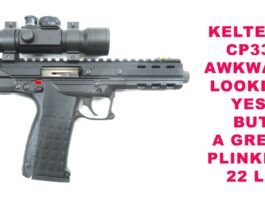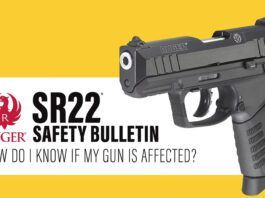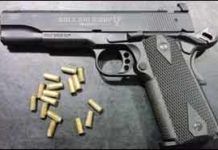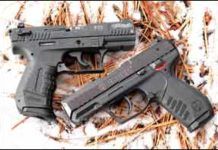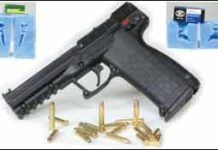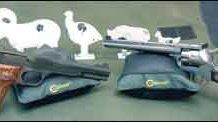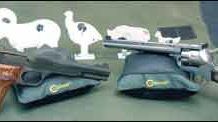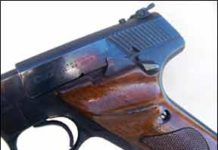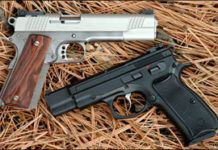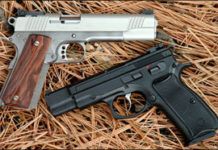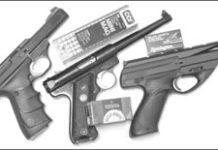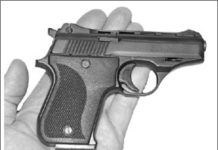1911 Replica Rimfires: GSG, Umarex, and Browning Compete
22 LR Semiautos: Walthers P22 Versus the Similar Ruger SR22
In a February 2006 test of four handguns, our Idaho staff called the Walther P22 22 LR No. WAP22003, $301, an "Our Pick." The test team said, "We liked this little .22 pistol immensely. It was completely reliable in our limited shooting, and shot very well, with many five-shot groups going around an inch at 15 yards. The impact could be fine-tuned as necessary by changing the front sight. The windage was slick and handy, we found, and adjusted with relative ease.… We think anyone in need of a fine little .22 pistol that works every time and doesn't bust the bank need look no farther than the short-barrel P22. We thought it was an ideal fun gun, one we'd take in the backpack and not even know it's there." Then, in the May 2010 issue, we wrote, "Our Team Said: The unanimous decision was that the P22 was the top performer in our tests.…"
This is a difficult trick to manage for any handgun, because differing ammo selections, test conditions, individual pistol variations, and matchups can magnify the flaws found in any product, making it hard to get a top grade again and again.
But when a gun does that well over time, it can serve as a benchmark against which to test newer products, which in this case is the Ruger SR22PB Model 03600, $399. Like the Walther P22 WAP22003, now $379, Ruger's SR22 is full of angles and bumps and slots, but not so many serrations. The top of its anodized slide was smooth and semi-gloss, instead of the Walther's dead-flat black with longitudinal serrations. What would have impressed us mightily is if Ruger (or Walther) had attempted to copy the original Walther PPK for the 22LR, and brought it off nicely at a good sale price. No one makes that gun today, so far as we know. (If Ruger or Walther decided to do it, we suspect a great many fans of James Bond would buy the guns just for the fact that they look like the famous PPK. And if this hypothetical gun were far more accurate than either of these two test guns, we'd beat a path to the maker's door and buy one for ourselves.) But that veers off our current topic, which is pitting the two similar 22 autoloading pistols head to head.
We acquired a new Ruger and borrowed a locally owned, new-condition P22 for this test. We tested with five types of ammunition. These were CCI Green Tag Competition, Eley's Match EPS, CCI Mini Mag solids, Winchester Power Point HP, and Federal Classic High-Velocity. How does the new Ruger stack up against the Walther P22? Let's take a look feature by feature:
Lightweight, Very High Capacity, Pistols from Kel-Tec and FNH
In March 2005 we looked at the FN FiveseveN IOM model pistol (hereafter referred to as the 5.7). At the time, there was nothing else on the market to compare it to, so Contributing Editor Roger Eckstine covered it as a one-gun "Range Bag" report. In that review, he said, "Designed as a companion to the FN P90 Submachine gun, the FN Five Seven pistol is a lightweight polymer pistol chambered for 5.728mm ammunition. The 5.728mm round features a necked-down case similar to but smaller than the 223 Remington round…." That report continued, "Initially, sales of the Five Seven pistol were intended to be limited to military and law-enforcement [IMGCAP(1)]personnel because the 5.728mm ammunition is available with armor-piercing bullets. However, the FN Five Seven pistol is now available to civilians.
"We loaded our 10-round magazines with the FN-supplied 31-grain open-tipped FMJ rounds and headed to the range. We found the FN Five Seven to be a very lightweight pistol, weighing only 21 ounces unloaded. To house the overall length of the rounds, the grip was longer front to back than those found on most pistols, making it a little harder to connect the hands when using a two-hand grip. Right-handed shooters had to work a little harder to get their thumbs around to press the magazine release. In fact, the safety release and the slide-release levers were in opposite positions from what we are used to. The slide release was to the rear, and the ambidextrous thumb safety was located above the trigger so that the shooter had to use the weak-hand thumb or trigger finger to operate the safety. All levers were polymer, just like the frame and top-end shroud."
And the money graf from the original report: "Buy It. We're not entirely settled on the fight-stopping capability of the civilian-issue 5.728mm ball ammunition, but we feel FN did an excellent job of bringing together design features such as a fine trigger, manual safety, a first-class accessory rail, ease of maintenance, and foolproof accuracy in an ultra-lightweight package."
Well, that was then, and this is now. In the last year, Kel-Tec CNC Industries of Cocoa, Florida, has brought out the PMR-30, chambered in 22 Winchester Magnum Rimfire, a gun influenced by Swedish designer and Kel-Tec founder George Kellgren's Grendel P30 22 Magnum autoloader. But even the P30 was predated by earlier 22 WMR autoloaders by AMT (the AutoMag II is now made by High Standard) and Excel Industries (MP-22, www.ExcelArms.com). All in, the PMR-30 is slightly lighter than the 5.7, and it has a 30-round magazine, 10 more than the FN's 20-rounder. They both fire 40-grain projectiles of nearly the same diameter, but at different velocities. Before we get to the guns, let's examine how the cartridges compare.
Smith & Wesson Vs. Ruger: 22 LR Wheelguns and Pistols
The International Handgun Metallic Silhouette Association (IHMSA) recently instituted a new division aimed at attracting more shooters competing at a maximum distance of 100 yards or meters. As explained on the www. IHMSA.org website, the rimfire arm of the Practical Hunter division is open to 22 LR handguns only with open sights, optical, or red-dot scopes. Competitors can shoot from any safe position they choose, including prone. New shooters may use a sandbag or mechanical rest to support the gun.
We decided to review some of the guns that would be a good choice for competing in IHMSA's Practical Hunter rimfire division. For quick reference we opened up our DVD copy of the Firearms Guide 2011 database ($40 from www.FirearmsMultimediaGuide.com) and found almost 80 pistols and revolvers that would be eligible to compete, along with their specifications and schematics. Economy was the goal, but we didn't want to buy the least expensive gun and risk outgrowing its capabilities. We were also split over choosing a revolver or a semi-automatic pistol. So we chose two of each.
Our revolvers were the Smith & Wesson 617 double-action revolver with single-action capability and Ruger's New Model Single Six Hunter. The Smith & Wesson was a smallbore version of the L-frame 686 revolver, and the Ruger was the smallbore brother to the New Model Super Blackhawk Hunter single-action revolver. On the pistol side we decided to stay with the same manufacturers. The Smith & Wesson Model 41 has been in production since 1957. The Ruger Mark III Competition is the latest version of the popular pistol that often comes to mind when shooters talk about target shooting.
Since accuracy was the primary concern, our test procedure was simple. Firing from a bench we would shoot the best groups possible. For support we chose the Caldwell Matrix shooting rest with the rifle extension removed. Augmented with sandbags to support the shooter's head as well as his arms, the only thing moving was the trigger finger. Most full-size pistols are tested from the 25-yard line, but the nearest steel silhouette was going to be 50 yards away. Even with the fine target sights found on each of our handguns, it was our opinion that 50-yard shots would require a scope. All four of our guns came with accommodation for mounting a scope, but with the extraordinary winds that were blowing, we were afraid that conditions might trump even the best optics. Finally, we decided to test from the 25-yard line with the supplied open sights.
The first gun we tested was the New Model Single Six Hunter, and here is why. The Hunter is a convertible model that comes with two cylinders, one for chambering 22 LR and the other for 22 Winchester Magnum Rifle. The WMR bullets are a little bit wider (.222 vs. .224). According to a Ruger representative, the bore would favor the wider magnum rounds, but we should be able to find a number of 22 LR rounds that shoot very well in the Hunter nonetheless. After trying several different rounds of 22 LR in the Ruger revolver, we chose the three most accurate rounds. They were CCI's new high-velocity AR Tactical rounds, CCI Standard Velocity ammunition, and Lapua Midas Plus. All three were topped with 40-grain roundnosed bullets. Regarding velocity readings, the pistols were fired over the chronograph five times. The revolvers were chronographed according to their full cylinder capacity, six shots from the Ruger and 10 from the Smith & Wesson 617.
Shooting in the wind required us to wait for calm between gusts. Some of our hold periods took minutes, not seconds. Since both revolvers were shot single-action only, we lost time pulling back the hammer and reacquiring the sights between shots. The pistol tests didn't take as long to complete because during the periods of calm, we were able to put more consecutive shots down range without interruption. This could pay off at a match when trying to beat a time limit. Beyond accuracy, we looked for reliability plus how well each gun lent itself to being shot standing offhand and from other IHMSA-legal shooting positions. Let's start knocking them down.
Smith & Wesson Vs. Ruger: 22 LR Wheelguns and Pistols
The International Handgun Metallic Silhouette Association (IHMSA) recently instituted a new division aimed at attracting more shooters competing at a maximum distance of 100 yards or meters. As explained on the www. IHMSA.org website, the rimfire arm of the Practical Hunter division is open to 22 LR handguns only with open sights, optical, or red-dot scopes. Competitors can shoot from any safe position they choose, including prone. New shooters may use a sandbag or mechanical rest to support the gun.
We decided to review some of the guns that would be a good choice for competing in IHMSA's Practical Hunter rimfire division. For quick reference we opened up our DVD copy of the Firearms Guide 2011 database ($40 from www.FirearmsMultimediaGuide.com) and found almost 80 pistols and revolvers that would be eligible to compete, along with their specifications and schematics. Economy was the goal, but we didn't want to buy the least expensive gun and risk outgrowing its capabilities. We were also split over choosing a revolver or a semi-automatic pistol. So we chose two of each.
Our revolvers were the Smith & Wesson 617 double-action revolver with single-action capability and Ruger's New Model Single Six Hunter. The Smith & Wesson was a smallbore version of the L-frame 686 revolver, and the Ruger was the smallbore brother to the New Model Super Blackhawk Hunter single-action revolver. On the pistol side we decided to stay with the same manufacturers. The Smith & Wesson Model 41 has been in production since 1957. The Ruger Mark III Competition is the latest version of the popular pistol that often comes to mind when shooters talk about target shooting.
Since accuracy was the primary concern, our test procedure was simple. Firing from a bench we would shoot the best groups possible. For support we chose the Caldwell Matrix shooting rest with the rifle extension removed. Augmented with sandbags to support the shooter's head as well as his arms, the only thing moving was the trigger finger. Most full-size pistols are tested from the 25-yard line, but the nearest steel silhouette was going to be 50 yards away. Even with the fine target sights found on each of our handguns, it was our opinion that 50-yard shots would require a scope. All four of our guns came with accommodation for mounting a scope, but with the extraordinary winds that were blowing, we were afraid that conditions might trump even the best optics. Finally, we decided to test from the 25-yard line with the supplied open sights.
The first gun we tested was the New Model Single Six Hunter, and here is why. The Hunter is a convertible model that comes with two cylinders, one for chambering 22 LR and the other for 22 Winchester Magnum Rifle. The WMR bullets are a little bit wider (.222 vs. .224). According to a Ruger representative, the bore would favor the wider magnum rounds, but we should be able to find a number of 22 LR rounds that shoot very well in the Hunter nonetheless. After trying several different rounds of 22 LR in the Ruger revolver, we chose the three most accurate rounds. They were CCI's new high-velocity AR Tactical rounds, CCI Standard Velocity ammunition, and Lapua Midas Plus. All three were topped with 40-grain roundnosed bullets. Regarding velocity readings, the pistols were fired over the chronograph five times. The revolvers were chronographed according to their full cylinder capacity, six shots from the Ruger and 10 from the Smith & Wesson 617.
Shooting in the wind required us to wait for calm between gusts. Some of our hold periods took minutes, not seconds. Since both revolvers were shot single-action only, we lost time pulling back the hammer and reacquiring the sights between shots. The pistol tests didn't take as long to complete because during the periods of calm, we were able to put more consecutive shots down range without interruption. This could pay off at a match when trying to beat a time limit. Beyond accuracy, we looked for reliability plus how well each gun lent itself to being shot standing offhand and from other IHMSA-legal shooting positions. Let's start knocking them down.
Colt Targetsman Versus Ruger’s 22/45: Which is the Bargain?
Colt Targetsman Versus Rugers 22/45: Which is the Bargain?
22 LR Semiauto Shootout: ISSC, SIG Sauer, and Walther
As ammo prices continue to rise and availability remains spotty, more and more firearm enthusiasts are looking for less costly ways to extend their time on the shooting range. A natural solution is the 22 rimfire cartridge. Besides its cheaper price and greater availability, the recoil-friendly round makes it an excellent choice for those who are new to firearms. It's also a good choice as a training round for experienced shooters looking to refine their technique.
Some manufacturers have begun to recognize this trend, and have begun manufacturing models designed to meet this new demand. We recently evaluated three AR-style rifles chambered in 22 LR in the February 2010 Issue. This month we decided to look at three semiautomatic pistols which could function as low-cost shooting trainers.
One model, the single-action-only ISSC M22, $400, has been specifically marketed as a training gun. Our other two models for this evaluation were double action/single models: the full-size SIG Mosquito ($390) and the smaller-framed but ample Walther P22 ($400). All three models shared some common features: blowback operated, ambidextrous safety levers, adjustable sights, and magazine disconnects. All three also had internal key-activated safeties. The P22 and M22 had one other thing in common—the same inventor, Austrian designer Wolfram Kriegleder—who designed the P22 for Walther, then later collaborated with ISSC on the M22.
We began our testing expecting it to be a straightforward affair; instead, we had one of the more difficult evaluations we've had in some time. You don't see out-of-battery ignitions very often.



























